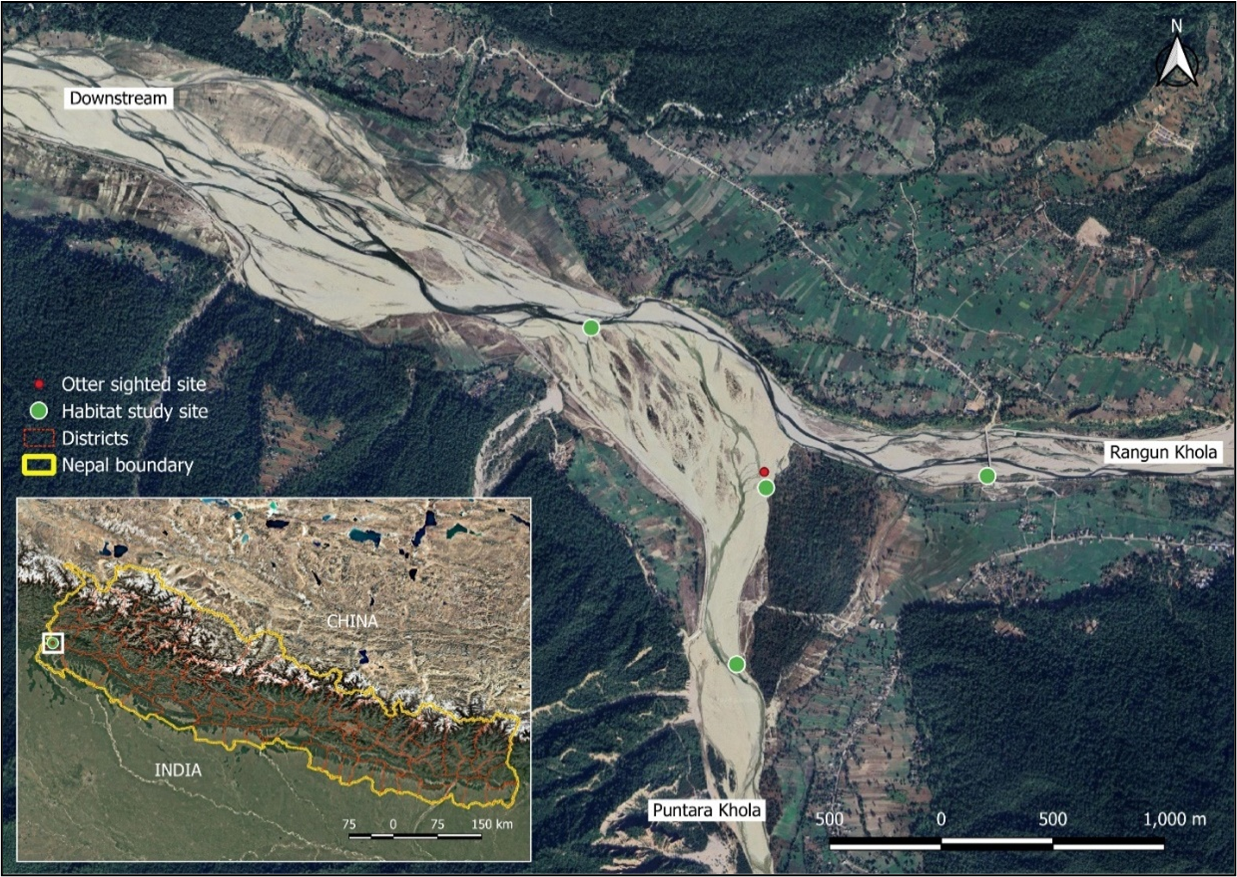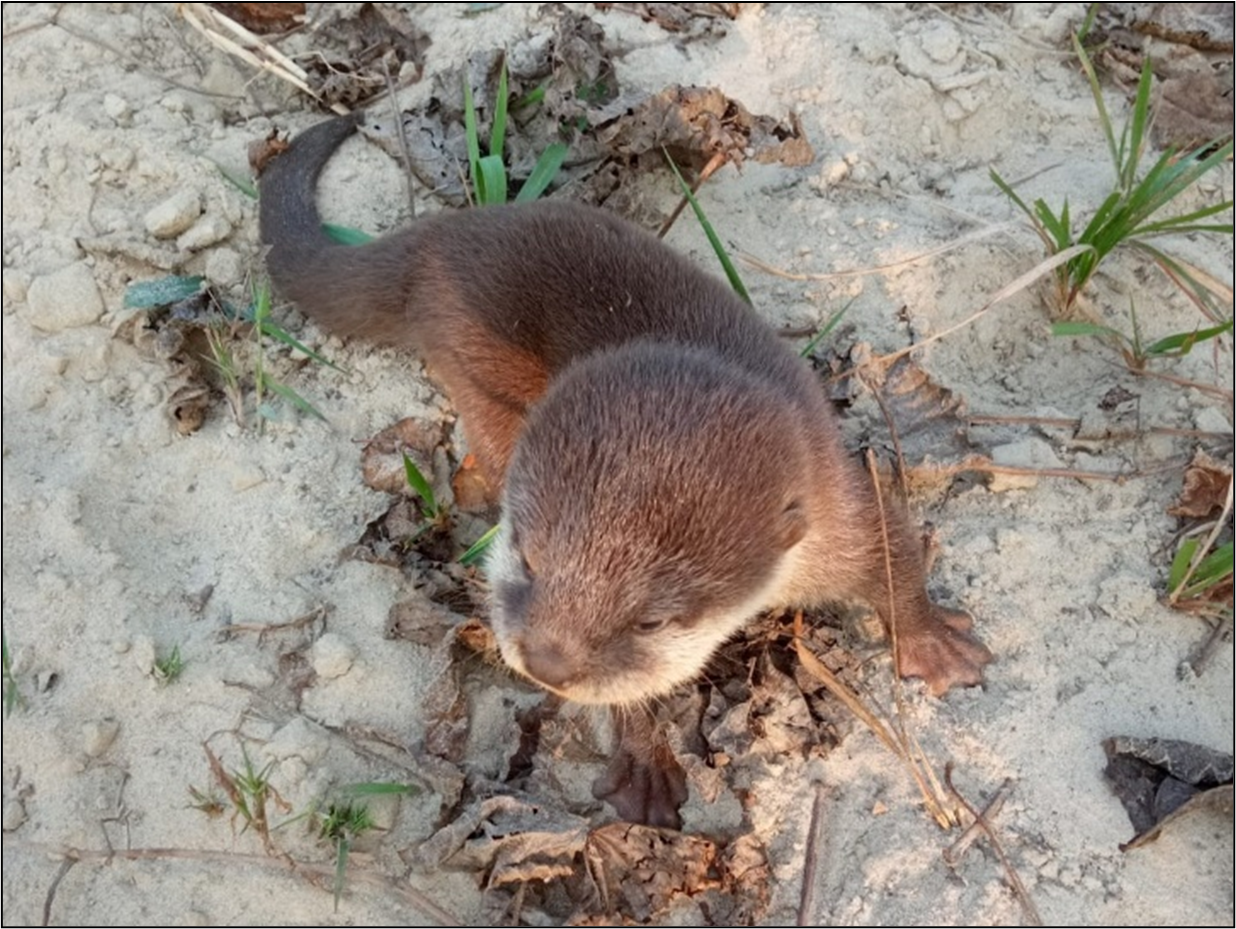IUCN/SSC Otter Specialist Group Bulletin

©IUCN/SCC Otter Specialist Group
Volume 42 Issue 1 (January 2025)
Citation: Shrestha, M.B., Shrestha, G., Dangaura, H.L., Chaudhary, R., Shrestha, P.M., Dewan, K., Sada, R., Savage, M., and Zuofu Xiang (2025). Confirmation of the Presence of Asian Small-Clawed Otter Aonyx cinereus in Nepal after 185 Years. IUCN Otter Spec. Group Bull. 42 (1): 3 – 8
Confirmation of the Presence of Asian Small-Clawed Otter Aonyx cinereus in Nepal after 185 Years.
Mohan Bikram Shrestha1*, Ganga Shrestha2, Hiru Lal Dangaura3, Rajeev Chaudhary4, Purna Man Shrestha2, Karun Dewan5, Rajesh Sada5, Melissa Savage6, and Zuofu Xiang1
1College of Forestry, Soil and Water Conservation, Central South University of Forestry and Technology, Changsha, Hunan, China
2Wildlife Research and Education Network, Tokha, Kathmandu, Nepal
3Bird Conservation Nepal, Lazimpat, Kathmandu, Nepal
4Division Forest Office, Dadeldhura, Nepal
5WWF-Nepal
6University of California, USA
*Corresponding Author Email: shrmohan5@gmail.com
Received 1st December 2024, accepted 5th December 2024
Abstract: The Asian Small-clawed Otter has not been observed in Nepal since 1839. Because of a lack of evidence of the species over such a prolonged period, it has been sometimes suggested that it is extinct in the country. Here, we present the first photographic evidence of Asian Small-clawed Otter in Nepal in 185 years. In November 2024, a juvenile Asian Small-clawed Otter was captured at the confluence of Rangun Khola and Puntara Khola of Dadeldhura District in far-western Nepal, was nurtured in the Forest Office for a week before released to the wild. The presence of a juvenile otter implies the presence of other otter individuals in the area. This rare observation is a significant confirmation of the species presence in Nepal and warrants detailed study and conservation initiatives to conserve the species.
Keywords: Asian Small-clawed Otter, rediscovery, Rangun Khola, Puntara Khola, Nepal
INTRODUCTION
Nepal has been said to be home to three species of otters, smooth-coated otter (Lutrogale perspicillata), Eurasian Otter (Lutra lutra) and Asian Small-clawed Otter (Aonyx cinereus) (Acharya and Rajbhandari, 2011). Confirmed evidence for the presence of Small-clawed Otters in Nepal has been lacking since the mid-19th century. The Asian Small-clawed Otter was last reported by Hodgson in 1939 (Hodgson, 1839). The Smooth-coated Otter has been the most studied Otter species of Nepal. Studies on Eurasian Otter is gaining momentum in recent years. The species’ status was ambiguous for decades till was observed in the Barekot, Roshi and Tubang Rivers (Shrestha et al., 2021), in the Pelma River (Shrestha et al., 2022) and in area of Kathmandu Valley (Shrestha et al., 2023). In contrast, Asian Small-clawed Otter have not been recorded in Nepal; for more than a century and a half since 1839 (Acharya et al., 2023). Only anecdotal records from Nepal were in from Makalu Barun National Park, Kailali and Kapilvastu Districts (Jnawali et al., 2011). Globally categorized by the IUCN as Vulnerable (Wright et al., 2021) and listed as Data deficient species in National Red List Assessment of Mammals of Nepal (Jnawali et al., 2011). Deficient information on Asian Small-clawed Otter made its status in Nepal indeterminate (Jnawali et al., 2011).
OTTER SIGHTING SITE AND SPECIES IDENTIFICATION
In November 2024, a juvenile Asian Small-clawed Otter was sighted at the river junction of the Rangun Khola and its feeder stream the Puntara Khola at Parsuram Municipality-12 of Dadeldhura District in far-western Nepal (29.132819˚N 80.335374˚ E; 401m asl) (Fig. 1). Downstream, the Rangun Khola flows into the Mahakali River (also called as Sarada River) and then into the Karnali River in India.
Morphological characteristics and species identification of the otter in photographs and videos confirmed as an Asian Small-clawed Otter by IUCN Otter Specialist Group members (Fig. 2). The species has front paws with reduced nails, well adapted for catching small vertebrate and invertebrate prey in shallow and murky water (Hussain et al., 2011; Nicole Duplaix, pers. comm.). The juvenile otter was captured by a local, transferred to the nearby Sub-division Forest Office and nurtured for a week before released to the wild. The Forest Officer (co-author) shared photographs and videos with otter researchers in Nepal (primary author) for species identification, which was further forwarded to IUCN Otter Specialist Group members for the confirmation.
HABITAT NOTE
A brief habitat study was carried out 1-km upstream and downstream from the otter sighting location as a baseline for future study. The habitat characterstics of four sites were noted: the otter observation location, 1-km upstream at the Rangun Khola and at feeder stream the Puntara Khola, and 1-km downstream in the Rangun Khola (Fig. 3). The location of the otter sighting was close to the human settlements Katar and Jogbudha. The bank-to-bank river width varied from 235-750m, but the river itself was shrunken due to the marked reduction of post-monsoon flow, with a tranquil flow and shallow depth. The riverbank was composed of large stones (˃10cm-0.5m), small stones (1-10cm) and sand and mud with higher cover of large stones. The bank vegetation cover was sparse with small patches of Imperata cylindrica and Chromolaena odorata. The otter was observed at the edge of leasehold forest, where mining of stone and sand, washing, bathing and fishing activities were common.

CONCLUSION
The sighting of an Asian Small-clawed Otter after 185 years is a remarkable discovery for conservation in Nepal, ending concerns that the species may have been extinct in the country. The sighting highlights the need for detailed study of the status of this species in Nepal and urgent implementation of conservation initiatives. Small-scale mining of construction materials from local rivers, primarily the Puntara Khola is likely to increase in the near future, with substantial impact on aquatic life. The traditional fishing practices using net casting, fishing hooks, draining water, and trapping fish in rice paddies are common. Besides, fishing using poison and explosives have been increasing. These activities will cause a decline in fish populations. Deforestation, habitat degradation, overgrazing, non-point source pollution and agricultural run-off are additional threats to the aquatic life in the area. There are five micro-hydro plants in the Rangun Khola with impacts to the aquatic biodiversity (USAID, 2018). Otters are resilient to highly modified anthropogenic landscapes (Lee, 1996; Theng and Sivasothi, 2016), flexible in habitat selection (Aadrean et al., 2010; Weinberger et al., 2016) and able to recover from low numbers (Marcelli and Fusillo, 2009; Uscamaita and Bodmer, 2010). Nevertheless, given the rare occurrence of Small-clawed Otter in Nepal, mitigation measures are urgently needed for conservation of the species int this region. National otter survey, scientific studies of ecology and phylogeny of the species and conservation measures at priority sites are called for. Nepal has shown an exemplary effort in the conservation of megafauna, resulting in significant population increases of species such as rhinoceros and tigers. A timely conservation effort for this exceptionally rare species, a keystone aquatic mesocarnivore is now urgently needed in Nepal.
Acknowledgments - Authors are grateful to the Sub-Division Forest Office and Division Forest Office of Dadeldhura for their support providing data. We are grateful to residents of Jogbudha and Katar, Dadeldhura for further information. We thank Nicole Duplaix, IUCN Otter Specialist Group Co-chair for the identification of the Asian Small-clawed Otter from photographs and videos.
REFERENCES
Aadrean, Salmah, S., Salsabila, A. and Rizaldi, Janra, M. N. (2010). Tracks and other signs of otters in rice fields in Padang Pariaman, West Sumatra: A preliminary study. IUCN Otter Spec. Group Bull. 27 (1): 6–11. https://www.iucnosgbull.org/Volume27/Aadrean_et_al_2010.html
Acharya, P. M., Thainiramit, P., Techato, K., Baral, S., Rimal, N., Savage, M, Campos-Arceiz, A., Neupane, D. (2023). Predicting the distribution and habitat suitability of the Smooth-coated otter (Lutrogale perspicillata) in lowland Nepal. Global Ecology and Conservation. 46 e02578: 1-14. https://doi.org/10.1016/j.gecco.2023.e02578
Acharya, P., Rajbhandari, S.L. (2011). Status of otters in Nepal. Report submitted to IUCN/SSC Asian Secretariat, Sri Lanka. http://ruffordorg.s3.amazonaws.com/media/project_reports/Status%20of%20Otters%20in%20Nepal.pdf
Hodgson, B. H. (1839). Summary description of four new species of otter. Journal of the Asiatic Society of Bengal. 8: 319-320. https://ia600505.us.archive.org/16/items/biostor-280351/biostor-280351.pdf
Hussain, S. A., Gupta, S. K., de Silva, P.K. (2011). Biology and ecology of Asian Small-Clawed otter Aonyx cinereus (Illiger, 1815): A review. IUCN Otter Spec. Group Bull. 28 (2): 63-75. https://www.iucnosgbull.org/Volume28/Hussain_et_al_2011.html
Jnawali, S.R., Baral, H.S., Lee, S., Acharya, K.P., Upadhyay, G.P., Pandey, M., Shrestha, R., Joshi, D., Laminchhane, B.R., Griffiths, J., Khatiwada, A. P., Subedi, N. and Amin, R. (compilers) (2011). The Status of Nepal Mammals: The National Red List Series, Department of National Parks and Wildlife Conservation, Kathmandu, Nepal. https://www.ntnc.org.np/sites/default/files/doc_publication/2018-11/The%20Status%20of%20Nepal%27s%20Mammals%20-%20Red%20List.pdf
Lee, L.L. (1996). Status and distribution of river otters in Kinmen, Taiwan. Oryx. 30 (3): 202–206. https://doi.org/10.1017/S0030605300021645
Marcelli, M., Fusillo, R. (2009). Assessing range re-expansion and recolonization of human-impacted landscapes by threatened species: A case study of the otter (Lutra lutra) in Italy. Biodiversity Conserv. 18 (11):2941–2959. https://doi.org/10.1007/s10531-009-9618-2
Shrestha, M.B., Shrestha, G. Reule, S., Oli, S. and Ghartimagar, T.B. (2022). Presence of evidence and factors affecting distribution of Eurasian otter (Lutra lutra) in the Pelma River, Rukum East, Nepal. OTTER, J. of the Int’l. Otter Survival Fund. 8:70-83. https://www.otter.org/s/Volume-8.pdf
Shrestha, M.B., Shrestha, G. Reule, S., Oli, S., Ghartimagar, T.B., Singh, G., Tripathi, D.M., Law, C.J., Shah, K. B. and Savage, M. (2021). First evidence of Eurasian otter in Nepal in three decades. IUCN Otter Spec. Group Bull. 38(5): 279-291. https://www.iucnosgbull.org/Volume38/Shrestha_et_al_2021b.html
Shrestha, M.B., Shrestha, G., Maharjan, M. and Shah, K.B. (2023). Unusual Sighting Record of Eurasian Otter (Lutra lutra) in Kathmandu Valley. OTTER, J. of the Int’l. Otter Survival Fund. 9: 64-71. https://www.otter.org/s/13891-IOSF-JOURNAL-2023_web.pdf
Theng, M., Sivasothi, N. (2016). The Smooth-coated otter Lutrogale perspicillata (Mammalia: Mustelidae) in Singapore: Establishment and expansion in natural and semi-urban environments. IUCN Otter Spec. Group Bull. 33 (1): 37–49 https://www.iucnosgbull.org/Volume33/Theng_Sivasothil_2016.html
USAID (2018). Rangun Khola Watershed profile: Status, challenges and opportunities for improved water resource management. USAID Paani Program, USAID/Nepal.
Uscamaita, R. M. and Bodmer, R. (2010). Recovery of the Endangered giant otter Pteronura brasiliensis on the Yavarí-Mirín and Yavarí Rivers: A success story for CITES. Oryx. 44 (1): 83–88. https://doi.org/10.1017/S0030605309990196
Weinberger, I.C., Muff, S., deJongh, A., Kranz, A., Bontadina, F. (2016). Flexible habitat selection paves the way for a recovery of otter populations in the European Alps. Biological Conservation. 199: 88–95. https://doi.org/10.1016/j.biocon.2016.04.017
Wright, L., de Silva, P.K., Chan, B., Reza Lubis, I., Basak, S. (2021). Aonyx cinereus. The IUCN Red List of Threatened Species 2021: e.T44166A164580923. https://dx.doi.org/10.2305/IUCN.UK.2021-3.RLTS.T44166A164580923.en
Résumé: Confirmation de la Présence de la Loutre Cendrée Aonyx cinereus au Népal après 185 Ans
La loutre cendrée n’a plus été observée au Népal depuis 1839. En raison du manque d’indices de présence de l’espèce sur une période aussi prolongée, il a parfois été suggéré qu’elle était éteinte dans le pays. Nous présentons ici la première preuve photographique de la loutre cendrée au Népal depuis 185 ans. En novembre 2024, une loutre cendrée juvénile a été capturée au confluent de Rangun Khola et de Puntara Khola dans le district de Dadeldhura, à l’extrémité ouest du Népal. Elle a été alimentée au Forest Office pendant une semaine avant d’être relâchée dans la nature. La présence de loutres juvéniles implique l’existence d’autres individus dans la région. Cette observation rare est une confirmation significative de la présence de l’espèce au Népal et justifie une étude détaillée et des initiatives de conservation afin de protéger la loutre cendrée.
Revenez au dessus
Resumen: Confirmación de la Presencia de la Nutria de Uñas Pequeñas Asiática Aonyx cinereus en Nepal después de 185 Años
La Nutria de Uñas Pequeñas Asiática no ha sido observada en Nepal desde 1839. Debido a la falta de evidencias de la especie por un período tan prolongado, se ha sugerido algunas veces que estaba extinguida en el país. Aquí, presentamos la primer evidencia fotográfica de una Nutria de Uñas Pequeñas Asiática en Nepal, en 185 años. En Noviembre de 2024, fue capturado un juvenil de Nutria de Uñas Pequeñas Asiática en la confluencia de Rangun Khola y Puntara Khola, del Distrito Dadeldhura, en el extremo occidental de Nepal, y fue mantenido y cuidado en cautiverio por la Oficina Forestal, durante una semana, para luego liberarlo al ambiente silvestre. La presencia de una nutria juvenil implica la presencia de otros individuos de nutria en el área. Esta rara observación es una confirmación significativa de la presencia de la especie en Nepal y amerita un estudio detallado e iniciativas de conservación para proteger a la especie.
Vuelva a la tapa











